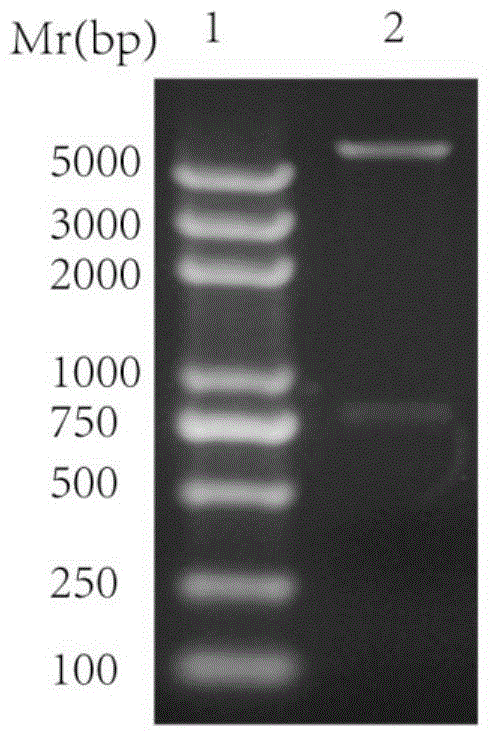Application of simian virus 40 capsid protein VP1 serving as cell transmembrane protein
A capsid protein and membrane-penetrating protein technology, applied in the field of cell transduction, can solve the problems of low practical utilization, strong damage, and low efficiency
- Summary
- Abstract
- Description
- Claims
- Application Information
AI Technical Summary
Problems solved by technology
Method used
Image
Examples
Embodiment 1
[0041] Simian virus 40 capsid protein VP1 gene, its preparation steps are as follows:
[0042] Using the pSV21SphI-N1 plasmid (Lietal, Small, 2009, 5:718-726) as a template, PCR amplification obtained the VP1 gene fragment of the simian virus 40 capsid protein, and the obtained VP1 gene sequence is shown in SEQ ID NO.1, which encodes The amino acid sequence is shown in SEQ ID NO.2. The upstream primer used in PCR: VP1-S (NcoI): 5′CAGACCATGGATGAGAGGATCGCATCACCATCACCATCACGGATCTATGAAGATG3′, the downstream primer: VP1-A (SacI): 5′GCTTGAGCTCGCACTGCATTCTAGTTGTGG3′. PCR cycle conditions: denaturation at 94°C for 5 min; denaturation at 90°C for 1 min, annealing at 53°C for 40 s, extension at 72°C for 1 min and 30 s, and 30 cycle reactions; finally, extension at 72°C for 10 min. The amplified product was subjected to 1% agarose gel electrophoresis, the target band was excised under ultraviolet light, and the gel recovery and purification kit from Omega Company was used to recover. Th...
Embodiment 2
[0044] Application of simian virus 40 capsid protein VP1 as a cell-penetrating peptide / verification of membrane penetration:
[0045] (1) CaCl for pET28a-hisVP1 plasmid 2 Transformed into E.coliRosetta (DE3) competent cells using the method, pick a single clone from the plate and insert it into 5mL LB test tube culture medium, and culture at 200r / min at 37°C overnight. The next day, transfer to 5mLLB test tube medium according to the inoculation amount of 1%, shake culture at 200r / min at 37°C overnight, transfer to 500mLLB Erlenmeyer flask on the next day, shake at 37°C and 200r / min until OD600 Between 0.4 and 0.6, add IPTG to a final concentration of 1 mM, continue to induce culture at 25 ° C for 8 h, collect the bacteria, and use loading buffer (25 mM Tris-HCl pH 7.8, 500 mM NaCl, 5 mM imidazole, 5 % glycerol) washed once, resuspended in 40mL of binding buffer for ultrasonication, centrifuged at 10000r / min for 30min, the supernatant was loaded on the Ni2+-NTA affinity chrom...
Embodiment 3
[0050] The application of monkey virus 40 capsid protein VP1 in the transduction of fluorescent protein mCherry into cells, the steps are:
[0051] (1) The fluorescent protein mCherry gene was inserted into the pET28a-hisVP1 vector through SacI and XhoI double restriction sites, and the plasmid pET28a-VP1mCherry was constructed, and the double restriction restriction plasmid was successfully constructed ( Figure 1-b ).
[0052] (2) The plasmid pET28a-VP1mCherry was transformed into E.coliRosetta (DE3) competent cells, and the monoclonals were picked from the plate for expansion and cultured, induced by IPTG, and purified by Ni2+-NTA column affinity chromatography to obtain the fusion protein VP1-mCherry .
[0053] (3) fusion protein VP1-mCherry polyacrylamide gel electrophoresis, the molecular weight of VP1 protein is about 70kDa, the molecular weight of VP1-mCherry detected by polyacrylamide gel electrophoresis is consistent with the predicted value ( figure 2 Middle lane...
PUM
| Property | Measurement | Unit |
|---|---|---|
| diameter | aaaaa | aaaaa |
| molecular weight | aaaaa | aaaaa |
| molecular weight | aaaaa | aaaaa |
Abstract
Description
Claims
Application Information
 Login to View More
Login to View More - R&D
- Intellectual Property
- Life Sciences
- Materials
- Tech Scout
- Unparalleled Data Quality
- Higher Quality Content
- 60% Fewer Hallucinations
Browse by: Latest US Patents, China's latest patents, Technical Efficacy Thesaurus, Application Domain, Technology Topic, Popular Technical Reports.
© 2025 PatSnap. All rights reserved.Legal|Privacy policy|Modern Slavery Act Transparency Statement|Sitemap|About US| Contact US: help@patsnap.com



